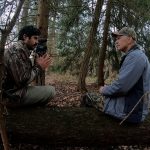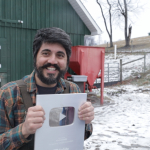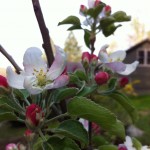Join the Free Online Business Webinar
Imagine you are watching majestic lions hunting their prey on the edge of the Kalahari Desert in Zimbabwe. These beautiful animals roam in packs, looking for vulnerable prey. Traversing wide, open spaces, the predators and their prey keep each other in balance.
On this episode of Homesteady, Aust introduces us to the work of Allan Savory, of The Savory Institute. Allan grew up in Zimbabwe, and regularly saw lions, elephants, and many other species while assisting his father in surveying the Hwange Game Reserve.
“My father made it impossible not to love the bush. By the time I left high school I could not imagine spending my life anywhere else.” Alan pursued a degree in ecology, and his life’s work is preventing desertification. Alan takes us through history, highlighting the fact that preserving our natural resources is necessary not only for our survival, but for maintaining a peaceful coexistence between nations. Again and again, wars have ensued over resources; gold, spices, oil. Imagine if the world was in a race for water. Land that has succumbed to desertification can no longer hold water to support plant life. EVEN WHEN IT RAINS. Alan shares with us that as homesteaders, we can truly be part of the solution.
People blamed livestock and overgrazing. The thought was the the livestock ate all the plants, and the bare land then resulted in desertification. However, Alan noticed that within wild herd, such as zebra, wildebeest, elk, or bison, the animals rotated through the land naturally. Wild herd animals graze in large, tightly compacted groups. This led
“Slowly,” says Alan, “The murky picture became clearer. The healthiest land I had seen was always associated with the largest herds.” On the grasslands, large, tightly compacted groups of prey animals were naturally rotated by the predators who were consistently were a few steps behind, waiting for an animal to break from the herd for their next meal. As the predators closed in, the herd would move, staying a step or two ahead of danger. After the herd had moved on, the land, fed by urine and dung of the animals, and enriched by trampled vegetation, would spring back, fertilized by its encounter with the animals.
Rotational grazing, which seeks to mimics the natural movement of wild herds, is a solution to the prevention of desertification. “In the United States,” Allan reports, “millions of cattle are fed grain in a fossil fuel based factory production system while so much of the land in the western half of the country is desertifying due to too few livestock.” The majority of livestock is raised in feedlots, where animal waste, instead of fertilizing the ground, becomes toxic waste in need of disposal. Allan encouraged farmers in Africa to adopt rotational grazing, even making a bet with the Rhodesian Minister of Agriculture that his methods could produce healthy land and support twice the amount of livestock in the current amount of space. Learn the whole story in this book, The Grazing Revolution.
Rotational grazing is heavily managed. It requires a planning, investment in equipment, and consistent monitoring. There are many practical applications for rotational grazing for farmers. Farmers who plant crops on fields that are first heavily grazed by cattle have reported seeing 2-5 times previous yields. But does it get Accountant Mike’s seal of approval? This debate actually originated on our episode To sheep or not to sheep, during which Aust pitches grazing sheep over buying a new lawnmower. Accountant Mike gives rotational grazing the thumbs up! For the first time, Aust took Accountant Mike’s advice, bought sheep, and, after trying to take a few shortcuts, took the leap into electric moveable fencing with help from Stephanie from Premier1 Supplies.
Stephanie from Premier1 Supplies uses moveable electric fencing to practice rotational grazing. She and her husband returned to his family farm to make a go at raising livestock after her father-in-law passed. With she and her husband both working off-farm jobs to continue to support their dream, Stephanie and her husband are able to move 100 head of cattle every weekend. She explains the many benefits of moveable electric fencing to meet the changing needs of her herd. This product is an important part of the history of Premier1. The company evolved from a sheep farm to a farm equipment company based upon the founder’s use of moveable electric fencing from England spreading in popularity amongst farmers in his area.
Intrigued by rotational grazing? Want to try it on your homestead? Plan carefully to accurately assess your needs! A solar powered energizer unit, electric netting, and a grounding rods complete a circuit that will give your livestock a little zing if they push their grazing boundaries. The amount and types of fencing, with different options available, runs between $230-$600 for a small homesteading herd. The time commitment per week for moving the fencing? Approximately 45-90 minutes. As homesteaders, this is one way we can positively affect the earth AND improve our bottom line.
Thank you to our partners for making this episode of Homesteady possible!
Is it time to start your fall seeds? Check out the GrowJourney Blog to find the right time for planting in your area.
Want a non-sales newsletter? Sign up for the Premier1 newsletter here.
Liked Stephanie from Premier1? Pioneers have access to this extended interview with Stephanie: How to install Electric Netting for Livestock.
Wait, do YOU want to be a Pioneer? Join here to access all the Pioneer content, including this month’s live webinar: how to start a farm. Make sure to wave hi to Dorinda, our Homesteady Pioneer of the Month!
Dorinda, I am going to post a picture of my bolted (and now I think fully dried out) spinach on Instagram. See the pic and follow The Suburban Escapee here. Share pics of your gardening triumphs and fails with the hashtag #iamhomesteady.
FREE Learning Opportunity!
As mentioned on the top of the show, Aust is hosting a FREE online business webinar! Sign Up HERE. With the guidance of Aust and Accountant Mike from the first Homesteady Launchpad I have gone from working 40+ hours per week outside my home, for someone else, to opening my own business. I now work outside the home only 25 hours per week. I STRONGLY encourage the webinar.
Lastly, to ensure your get all of Aust’s Jurassic Park References: Little Timmy from Jurassic Park.
From the Suburban Escapee
Normally, Aust is promoting something that I then have to talk my husband out of. Case in point: ducks. However, I am really into this fencing. And here’s why: my lawn.
After the aforementioned sheep episode (it really is hilarious), I began to take a closer look at my own lawn. This is our fourth summer in our home. And my husband says to me, “This year, we actually have weeds in our grass.”
It was true. When we purchased our home four years ago, we had 2/3 of an acre that mimicked a golf course. Not only did it look like a driving range, we learned the following summer that nothing grew in our “garden” except chives. Admitting defeat, we dug a giant hole in the middle of the front lawn, added a raised bed and continued to minimally maintain the “lawn” aspect of our lawn.
Keep in mind: while I don’t live in a subdivision, I do live in a neighborhood with stereotypical lawns. As we got to know our neighbors, we learned that the previous owner of our home was a green grass fanatic and a very frugal person who had an above ground pool he kept clean not with chlorine, but bottles of BLEACH.
We realized why nothing was growing. Our soil had 30 years of chemical lawn maintenance with splashes of bleachy pool water supplementing its makeup. (That explained why there was a circle in the backyard where there wasn’t even GRASS.)
With this information, we began to deliberately put nutrients back into our lawn. My husband purposefully mulched the grass on top of the lawn when he mowed as opposed to collecting and moving the grass clippings. We fertilized with dried cow blood to add nitrogen, dried kelp to add a wide variety of minerals and growth stimulants, and rock phosphates to add phosphorus. In addition to composting in an organized way, we began to randomly throw half eaten fruit and veggies into the yard for the birds, squirrels, and bunnies. When we pulled weeds from our raised bed, we threw them onto the lawn. We have had chickens now that we allow to free range over the lawn (though now I want moveable fencing), and I save all the eggshells for compost. We have bees (just got them this year!) to pollinate our garden.
This summer, we got to see the stark contrast between the land we had been feeding and the dirt that we revealed last fall when we took down a rotting front deck. For the first time, our plants that we planted directly into the ground, GREW. Our raspberries and blackberries have exploded! A sad grape vine that had been not *quite* dead yet has six bunches of grapes! We have a small patch of onions and potatoes, and sewed peas and beans in an extension to our raised bed with much less added soil, and had a great yield.
And the dirt that was hidden (until now) under our deck? Until mid July, not even crabgrass grew in it.
Now, I’m intrigued: the zoning laws in Massachusetts prevent me from getting certain types of livestock, even though I technically have the space for a little goat or two. But I could add to my chicken flock (we’re down to three chickens, because, predators) and rotate them around my lawn!
Dreams for next summer.
Are you intrigued by rotational grazing? Do you want to get a few goats or sheep? Let us know in the comments below!




What is the main song that plays throughout this episode?? It’s GORGEOUS! With the guitars and the simple melody played on like a slide guitar or something!
It’s some music I get from an online library of Royalty free music, not sure where you could get it James, mine site source is a membership site…